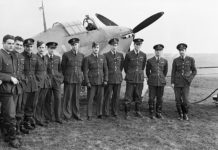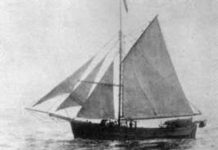Mail service in early colonial British North America was a sporadic, expensive event. Post offices were rare in the rural communities; the larger communities received mail deliveries on irregular schedules and pioneers travelled many miles to pick up their letters. “As late as 1835, for example, the settlers at Barrie, on Lake Simcoe, had to travel forty miles to the nearest post-office, at Newmarket,” said Marionopolis College’s Quebec History Encyclopedia in “History of the Postal System of Canada.”
Early Mail Service Expensive and Inefficient
At a cost of nine pence to send a single sheet of paper, postage was expensive, and the price to mail a second page was outrageous at “four times as great,” noted the Quebec History Encyclopedia. There were no stamps, and the carrier could claim the fee had not been paid. The letters would not be delivered. The system was highly unsatisfactory. It was time for change.
In 1850, the British transferred operation of postal affairs to the United Province of Canada. Instituting the Post Office Act, the government named James Morris as Canada’s first Postmaster General on February 22, 1851. The right man for the challenge, Morris took on the position with great interest and enthusiasm.
Morris Introduced Canada’s Own Postage Stamps
One of Morris’s first acts as Postmaster General was to organize the first stamps representing the new union of Canada. Young artist Sandford Fleming was tasked with creating innovative designs for stamps, and he did not let Morris down. The Three Pence Beaver became the United Province of Canada’s first postage stamp, issued in April 1851. The unique artwork featured the beaver hard at work, a symbol that would come to represent the spirit of Canadians. (Fleming was knighted Sir Sandford Fleming, recognized as the Father of Standard Time and one of Canada’s great surveyors and railway engineers.) Two other eye-catching postage stamps were released by Morris that year, one featuring Prince Albert, another depicting Queen Victoria.
In his two-year term, Morris lowered the excessive postage rates, reducing the cost of mailing a letter “from 16 cents to five cents,” according to The Lost Villages Historical Society: Morrisburg. “Postal services were greatly expanded and many towns received official post offices.” Visiting Washington, DC, Morris negotiated a postal treaty between the Post-Office Department of the United States and the Post-Office Department of Canada, so that there could be a regular exchange of mail between the neighbouring countries. The mail was not to be opened at any of the transitional postal offices, only at its destination.
Travelling Post Offices in Railway Cars
Morris also suggested travelling post offices to the Governor-General of the United Provinces of Canada. The idea was accepted, and the first mail train began operation in January 1854, running between London, Ontario and Niagara Falls. Employing Postal Conductors and then Railway Mail Clerks, the letters were cancelled and sorted right on the trains for delivery to towns along the rail-lines.
A Scotsman by birth, James Morris was born on November 1, 1798 in the town of Paisley, Renfrewshire. At only three years of age, the wee James immigrated to Elizabethtown in Upper Canada with the Morris family. The family returned to Scotland a year later, then moved back to Elizabethtown in 1808. (Elizabethtown became Brockville in 1812.) The young James Morris worked as a cashier at Brockville’s Commercial Bank of the Midland District and then moved into business and politics.
Politician and Speaker James Morris
Appointed Justice of the Peace in 1825, Morris was appointed coroner and member of the board of police in the 1830s. He worried about the unsettled condition of the colony, asking if “as colonists we shall ever have peace,” said P.G. Cornell in the entry, “Morris, James,” in the Dictionary of Canadian Biography Online. Elected as a member of Upper Canada’s House of Assembly in 1837, Morris was re-elected in 1841 in the newly formed United Province of Canada government. He held appointments over the years in the Legislative Council and Executive Council, and later, as Speaker of the House in 1853-1854. In 1858, James Morris was appointed Speaker of the Legislative Council of the United Province of Canada, and named Receiver General for the 1862-1863 term.
Morris was honoured for his work in canal administration and postal service with the renaming of the village of West Williamsburg to Morrisburg in 1851. Morris “gifted the sum of $100 to the village in appreciation of the honour paid to him,” stated the Lost Villages Historical Society. The gift was used to buy a bell for the public school. (The bell was located in a place of tribute in 1992, placed in a clock tower at the Morrisburg shopping centre.)
Married to Emily Rosamond Murney of Kingston, Ontario, the Morris family raised nine children. James Morris died on September 23, 1865 in Brockville. As Canada’s first Postmaster General, Morris provided the Post Office Department with a strong foundation from which to grow and flourish, evolving into today’s Canada Post Corporation. An historical plaque in the City of Brockville is a reminder of the invaluable work accomplished by James Morris for the benefit of Canada.
Sources:
- “History of the Postal System of Canada,” The Quebec History Encyclopedia, Marionopolis College
- The Lost Villages Historical Society: Morrisburg
- Cornell, P.G., “Morris, James”, Dictionary of Canadian Biography Online







